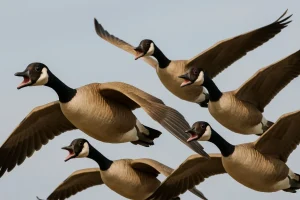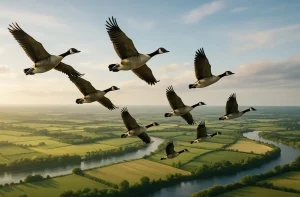Have you ever looked up on an autumn or spring day and wondered why geese glide across the sky in a perfect V shape? This remarkable sight is more than just a spectacle of nature. The V formation is a carefully evolved behaviour that provides survival advantages. It allows geese to conserve energy, travel greater distances, and stay united as a flock during long and often perilous migrations.
What Is the Science Behind the V Formation?

The V-shaped flight pattern is a result of aerodynamic efficiency. When a goose flaps its wings, it produces a small upward current of air, known as upwash, at its wingtips. The goose behind positions itself to catch this lift, reducing the effort required to stay airborne.
Research shows that geese flying in this pattern can travel up to 70 per cent farther than they would if flying alone. This efficiency becomes vital during migration, when journeys may span thousands of miles. By sharing the aerodynamic benefits, the flock increases its overall endurance and success rate.
What Role Does the Lead Goose Play?
At the tip of the formation, the lead goose breaks through the air resistance, taking on the most challenging position. This role, however, is not permanent.
Once the leader becomes fatigued, it drops back, and another goose moves forward to take its place. This rotation ensures that no single bird is overburdened, keeping the flock in steady progress.
The lead goose also plays a role in navigation. Positioned at the front, it has the clearest view of the route ahead, helping the flock avoid obstacles and remain on track along well-established migration paths.
How Do Geese Save Energy and Work as a Team?
Teamwork lies at the heart of the V formation. Each bird contributes to the flock by taking turns in leadership and by maintaining precise positioning. The shared effort reduces the energy expenditure of individuals, allowing the group to sustain long-distance travel.
This cooperation is not only practical but also essential for survival. A solitary goose would quickly tire on a migration journey, whereas the flock thrives by working as one.
How Do Geese Communicate and Coordinate During Flight?

Geese are rarely silent in flight. Their familiar honking serves several functions. It keeps the flock together, encourages birds that may be tiring, and maintains the rhythm necessary for consistent wingbeats. Communication allows the V shape to remain stable and ensures that each bird stays in its optimal position.
How Do Migration Routes Affect the V Formation?
Geese are migratory by nature, often travelling thousands of miles between breeding and wintering grounds. In the UK, greylag and pink-footed geese are well-known for their seasonal journeys. The V formation allows them to cover these long routes more efficiently than they could alone.
Other migratory birds, such as swans and pelicans, also adopt the same strategy, demonstrating that the V formation is a widely successful adaptation among large, long-distance flyers.
What Are the Advantages of the V-Shaped Flight Pattern?
The benefits of flying in a V are numerous and measurable. The formation provides aerodynamic efficiency, safety, and improved group coordination.
| Advantage | Explanation |
| Energy efficiency | Each bird saves energy by riding the upwash created by the one ahead. |
| Extended flight range | The flock can fly significantly farther compared to individual effort. |
| Navigational clarity | The lead goose sees ahead clearly, guiding the flock. |
| Group unity and safety | Communication and visibility help the flock remain intact. |
| Shared responsibility | Rotating leaders prevent exhaustion. |
What Can Humans Learn from Geese Teamwork?

The behaviour of geese offers more than biological insight; it provides a lesson in leadership and cooperation. Their ability to share responsibility, rotate leadership, and support one another demonstrates the effectiveness of teamwork.
Humans, too, can achieve greater results when responsibilities are shared and communication is prioritised.
Why Is the V Formation a Natural Wonder?
The sight of geese flying in a V formation is not simply a seasonal occurrence but a demonstration of evolutionary brilliance.
It highlights how animals adapt to challenges such as long migrations through cooperation and strategy. Through aerodynamics, teamwork, and communication, geese have developed one of the most efficient methods of group travel in the natural world.
FAQs About Geese Flying in a V
Do all birds fly in a V formation?
Not all birds do. While swans and pelicans also adopt this strategy, smaller species tend to migrate in looser flocks without a defined shape.
How far can geese travel in one migration?
Depending on species and route, geese can cover up to 3,000 miles, sometimes crossing entire continents.
Why do geese honk while flying?
The honking helps them communicate, stay together, and encourage weaker members of the flock.
Can a goose survive migration alone?
It is possible but far less likely. A solitary goose expends much more energy, loses the protection of the flock, and risks becoming disoriented.
Do other animals rely on teamwork like geese?
Yes. Dolphins coordinate while hunting, wolves depend on pack strategies, and ants succeed through collective organisation.
What happens when a goose becomes too tired?
A fatigued goose often drops back in the formation where flight is easier. In some cases, others will remain with it until it recovers.
How do young geese learn the V-shaped flight?
Young geese learn by instinct and imitation. Following older flock members, they quickly adopt the rhythm and discipline required to fly in formation.






